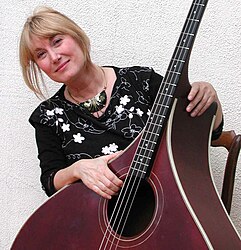Mandobass

Hilary James With mandobass
|
|
| Classification | |
|---|---|
| Related instruments | |
|
|
Mandobass is the largest (and least common) member of the mandolin family, sometimes used as the bass instrument in mandolin orchestras. It is so large that it usually isn't held in the lap, but supported on a spike which rests on the floor. The neck-scale length on a full-size mando-bass is similar to that of a standard orchestral double bass viol: about 43" (110 cm). The instrument is otherwise similar to the smaller, higher-pitched members of the mandolin family, having a fretted neck, a headstock with geared tuning machines, and a large resonating body often—but not always—shaped like that of other mandolins.
There are three main variants of the mandobass:
When mandolin orchestras were being organized in numbers, the members became aware of a problem of adding bass to their orchestras. In trying to play the bass range, many mandolin players were reluctant to switch to the contra-bass, because they saw it and its bowed action as intruding into their plucked-string world However they faced the problem that mandolin basses were too quiet; it was hard to get forte from them. Furthermore they didn't get the deep bass notes of the contra-bass. For those reasons most mandolin orchestras preferred to use the ordinary contra-bass, rather than a specialized mandolin family instrument. The bow not only helps with volume for forte sections of music, but the contra-bass has deeper notes available.
Up until 1911 the mandolin family of instruments as known in the United States had no true bass member. Mandolins were relatively new to the United States, beginning to be known in the mid 1880s and reaching the peak of popularity before 1910. The American public was mostly unaware of the few mando-basses being made in Europe. However, published minutes from the 1911 meeting of the American Guild of Banjoists, Mandolinists and Guitarists included an entry about bass mandolins developed in Britain, and indicate that issues related to the mando-bass were among the first discussed at the meeting. It was at this meeting that George D. Laurian of the Gibson Mandolin - Guitar Company announced that his department had developed a bass member for the mandolin family.
At the Guild's next meeting in 1912, four companies displayed their versions of a mando-bass: Gibson, Leland, Vega, and Wm. C. Stahl. All four companies advertised extensively, but in contrast to its competitors, only Gibson promoted their mando-bass in photographs of musicians playing it in large groups, emphasizing the social aspects of playing their instrument. Ultimately, the two most successful instruments were those produced by Gibson and Vega.
...
Wikipedia
